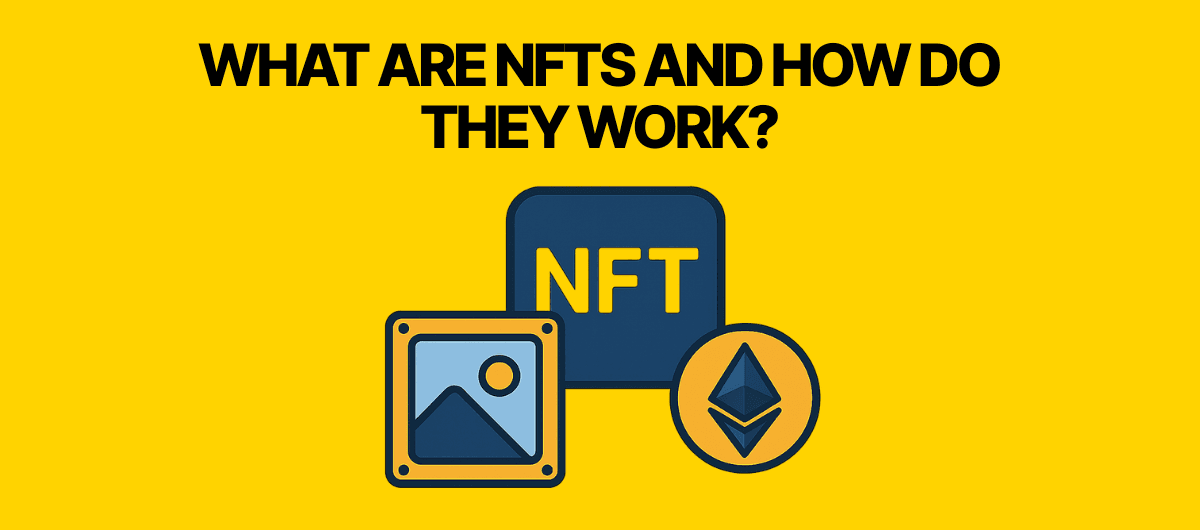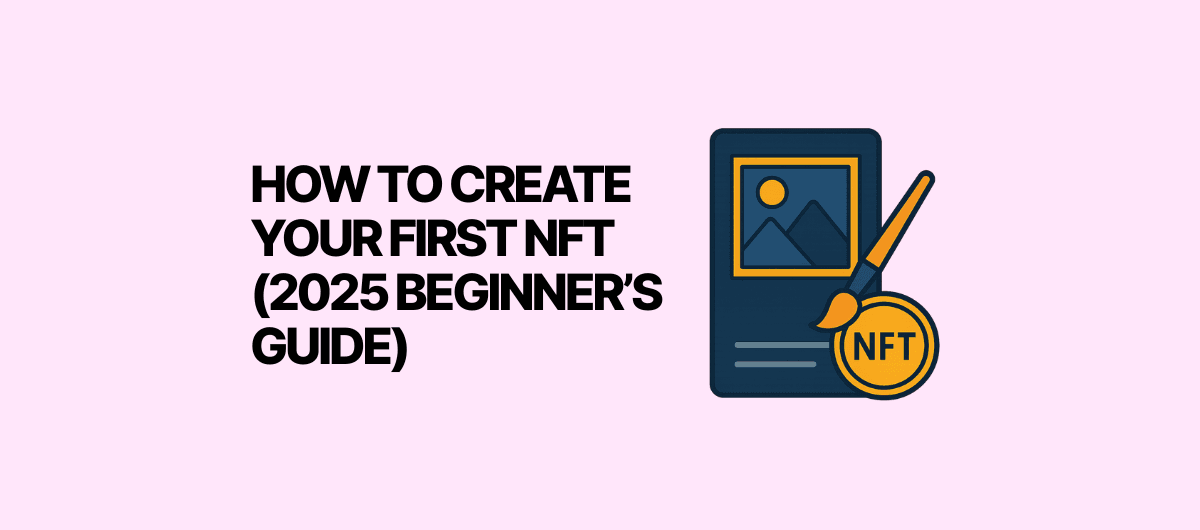What Are NFTs and How Do They Work? (2025 Guide)
Understand what NFTs are, how they work, and why they matter in Web3 — from digital art and gaming to identity, memberships, and real-world assets.

Hey, it’s Lanzo 👋
You’ve seen them everywhere — monkey pictures, digital art, gaming avatars.
But NFTs are much more than JPEGs. In 2025, they’ve evolved into one of the most flexible tools in Web3 — powering identity, memberships, and even real-world asset ownership.
In this guide, you’ll learn:
- What an NFT actually is (beyond the hype)
- How NFTs work on the blockchain
- Why they became popular — and what’s changed since 2021
- The real-world use cases (art, gaming, identity, property)
- How to store, buy, and secure NFTs safely
- What’s next for NFTs in Web3
Let’s decode the digital ownership revolution 👇
What Is an NFT? 🎨
NFT stands for Non-Fungible Token — meaning each one is unique and can’t be replaced by another token of the same kind.
Think of it like this:
- Bitcoin = fungible (1 BTC is equal to any other BTC).
- NFT = non-fungible (each token has unique data, traits, or ownership).
An NFT is a digital certificate of ownership recorded on a blockchain.
It doesn’t always store the artwork or file itself — instead, it stores a reference (like a link or hash) that points to that file, plus metadata proving who owns it.
Related: What Is Web3?
How NFTs Work on the Blockchain ⚙️
Each NFT is a smart contract that follows a standard — usually ERC-721 or ERC-1155 on Ethereum.
When an NFT is created (“minted”), the blockchain records:
- Who created it (wallet address)
- When it was minted
- Where the content is stored (IPFS, Arweave, or on-chain)
- Who currently owns it
That record can’t be changed or faked — which means true digital ownership.
When you buy or sell an NFT, you’re transferring that ownership entry from one address to another.
No centralized company needs to approve it — the blockchain verifies everything.
Why NFTs Blew Up in 2021 🚀
Back in 2021, NFTs became a cultural phenomenon.
Digital artists, collectors, and celebrities all joined the wave — from Beeple’s $69M sale to Bored Ape Yacht Club’s million-dollar avatars.
But behind the hype were real breakthroughs:
- Artists could sell directly to fans, without middlemen
- Gamers could own in-game items that worked across platforms
- Communities formed around token ownership (early Web3 social)
What started as “digital collectibles” became a new ownership layer for the internet.
And now, in 2025, NFTs are evolving far beyond art drops.
Beyond Art: Real NFT Use Cases in 2025 🌍
NFTs have matured into powerful utility tokens across industries.
Here’s where they’re being used right now:
🎮 Gaming & Metaverse
- NFTs represent in-game assets — skins, weapons, or characters you truly own.
- Interoperability lets you carry items between games (like digital luggage).
- Example: Immutable X and Polygon host major gaming ecosystems.
🪪 Identity & Reputation
- NFTs can serve as decentralized IDs (DIDs) — proving who you are online without leaking personal data.
- Think: a verified on-chain resume or credential system.
- Projects like Lens Protocol and ENS (Ethereum Name Service) lead this space.
💳 Memberships & Access
- NFTs now function as digital passes for exclusive communities, events, or premium services.
- Example: owning an NFT could unlock Discord access, product drops, or conference entry.
🏠 Real-World Assets (RWA)
- Real estate, cars, and collectibles are being tokenized as NFTs — simplifying proof of ownership and transfer.
- Combined with stablecoins, this bridges TradFi ↔ Web3.
🎨 Art & Culture (Still Strong)
- Artists still use NFTs to verify originality and get royalties automatically through smart contracts.
Lanzo Tip: NFTs are no longer just flex — they’re function.
Anatomy of an NFT 🧬
Every NFT has three core components:
- Smart Contract: defines the rules (ownership, transfers, royalties).
- Metadata: stores name, traits, rarity, creator details.
- Media File: the actual art, video, or 3D model (hosted on IPFS/Arweave).
If any of these three fail, your NFT might lose meaning — that’s why decentralized storage (like Arweave) matters more than ever.
Buying Your First NFT 🛒
Buying an NFT isn’t hard — but it requires understanding how wallets and marketplaces work.
- Choose a blockchain — Ethereum, Polygon, Solana, or Base.
- Set up a wallet — MetaMask, Ledger, or Trust Wallet.
- Add crypto — buy ETH or SOL on Bybit, then transfer to your wallet.
- Connect to a marketplace — like OpenSea, Magic Eden, or Blur.
- Verify the collection — check blue checkmarks and contract addresses.
- Confirm the transaction — gas fee + ownership transfer.
How to Store NFTs Safely 🔒
Owning an NFT doesn’t mean it’s secure.
If your wallet gets hacked, your NFTs can be gone forever.
Best practices:
- Use hardware wallets (Ledger, NGRAVE) for storage.
- Keep NFTs in cold wallets — separate from daily DeFi or trading accounts.
- Don’t click “Connect Wallet” on random NFT sites.
- Use burner wallets for minting new collections.
NFT Scams and How to Avoid Them ⚠️
Sadly, NFT scams are still common — but easy to avoid with awareness.
Watch out for:
- Fake marketplace links or Twitter giveaways.
- Phishing DMs (“claim your airdrop”).
- Malicious approvals that drain wallets.
- Suspicious “free mint” sites asking for seed phrases.
- “Support staff” impersonators in Discord.
If something feels urgent, it’s probably a scam.
Always verify the official project links — and never share your recovery phrase.
How Royalties Work 💸
One of the biggest innovations NFTs brought is creator royalties — automatic payments to artists every time their work resells.
Example:
- Artist mints NFT with 5% royalty
- Collector sells it on OpenSea
- Smart contract sends 5% of sale price back to the artist
This changed digital art forever — creators get paid for ongoing value, not just the first sale.
Even though royalty enforcement has evolved, the concept remains core to Web3 creator economics.
Environmental Concerns 🌱
Early critics argued NFTs harmed the environment due to Ethereum’s proof-of-work system.
But since Ethereum’s Merge to proof-of-stake, energy use dropped by 99.9%.
Today, minting or trading NFTs has roughly the same carbon footprint as sending an email.
Other chains like Polygon, Tezos, and Solana are even more energy-efficient — proving sustainability is no longer a blocker.
The Future of NFTs (2025 and Beyond) 🔮
NFTs are shifting from collectibles to infrastructure:
- Identity layers for social and professional networks
- RWA tokenization for property and equity
- Composability — NFTs interacting with DeFi and DAOs
- Gaming economies where assets live beyond a single game
- Interoperable avatars and metaverse credentials
By 2030, you won’t say “I own an NFT.”
You’ll just say “this is my membership,” “my property,” or “my profile.”
NFTs will simply be there, quietly securing digital ownership behind the scenes.
TL;DR 📌
- NFT = Non-Fungible Token, a unique blockchain asset proving ownership.
- Works via smart contracts (ERC-721/1155).
- Used for art, gaming, memberships, identity, and real-world assets.
- Store safely on hardware wallets.
- Avoid scams — always verify links and contracts.
- NFTs are the digital property rights layer of Web3.
- The future isn’t about hype — it’s about utility.
FAQ
Yes — NFTs have evolved from collectibles into infrastructure for identity, access, and ownership across Web3 and real-world assets.
Start Exploring NFTs Safely 🎨
Bybit — Buy ETH & Explore NFT Markets
Buy ETH or USDT with low fees, then explore NFT marketplaces and Web3 apps with confidence.
This is an affiliate link. If you buy, Lanzo may earn a commission at no extra cost to you.
Ledger Nano X — Secure Your NFT Collection
Industry-standard EAL5+ hardware wallet that protects your NFTs and crypto assets offline.
This is an affiliate link. If you buy, Lanzo may earn a commission at no extra cost to you.
NGRAVE ZERO — Premium Airgapped Wallet
EAL7 (CL7) certified, 100% offline device for NFT and crypto security — no USB, no Wi-Fi, no risk.
This is an affiliate link. If you buy, Lanzo may earn a commission at no extra cost to you.
CoinLedger — Track NFT Portfolio & File Taxes
Automatically sync your wallets, track NFT values, and generate crypto tax reports. Use code **CRYPTOTAX10** for 10% off.
This is an affiliate link. If you buy, Lanzo may earn a commission at no extra cost to you.
⚡ Lanzo Tip: NFTs aren’t just collectibles — they’re proof of ownership for everything digital. Learn the tech, stay safe, and enjoy the creative side of Web3.
⚠️ This post is for educational purposes only and does not constitute financial advice.
(This post contains affiliate links — supporting Lanzo at no extra cost to you.)
You might also like
Not financial advice. Based on public sources. As of today.


